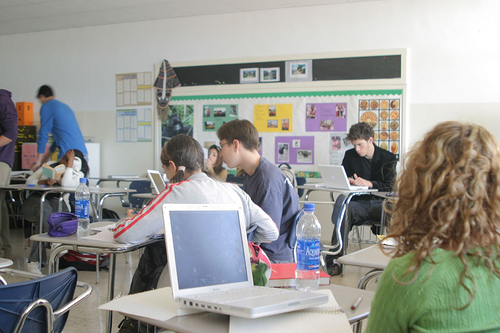Blended Learning
(![]() : this image should be removed because it has an NC restriction on it. Randy Fisher 15:30, 26 July 2010 (UTC)]])
: this image should be removed because it has an NC restriction on it. Randy Fisher 15:30, 26 July 2010 (UTC)]])
"Blended learning is the integration of classroom learning with elearning. For example, an instructor might use the classroom to present critical concepts, and then use an online discussion forum to encourage student dialogue around the concept. Or, an online course might meet in a classroom or a lab to practice skills." (Siemens, 2005) from eLearnspace
There is a relatively new term of Blended Online Learning that deals with blending some of the different modes of online learning mentioned below, especially blending synchronous with asynchronous modes.
Contents
Objectives
- To identify ways of blending face-to-face learning with e-learning tools.
- To provide links to find tools in order to facilitate blended learning.
- To provide examples where blended learning has been successful.
- To consider the implications of using blended learning in the classroom.
Using generic software
Programs
Potential Uses
- Wordprocessing software
- interactive exercises using pull downs or drag and drop
- organising and ordering text based information (e.g. putting information into an appropriate sequence)
- cloze exercises (e.g. fill in the missing words)
- simple mind mapping using drawing tools
- hyperlinked worksheets (e.g. to record answers to a web quest activity)
- Spreadsheet software
- graphical demonstration of 'what-if' analysis (e.g. if price increases, what happens to revenue)
- Presentation software
- deliver text, graphics, video, sound based information (e.g. in a sequence of slides)
Examples
Web Quest - Quest Garden
Drag and drop - Excellence Gateway
Issues for ‘blending’
- Teaching staff require some skill and expertise with ICT in order to devise these kind of activities. However, many activities are being stored in repositories which can be shared across schools and colleges. E.g. Teacher Resource Exchange
Using a LMS
Description
Often referred to as a Virtual Learning Environment (VLE), a Learning Management System (LMS) is computer software that enables a school/college to manage learning objects, courses and students. A LMS can provide administrative tracking of participation as well as editing/authoring tools for teachers.
Examples
- Canvas LMS Open Source software
- Moodle Open Source software.
- Interact Open Source software.
- Blackboard Proprietary software.
- ProProfs SaaS software
Issues for ‘blending’
- Teaching staff need to become familiar with the software tools provided in the system - e.g. creating quizzes, setting up classes, accessing reports etc.
- Teachers need to be willing to share their resources with others, ensuring that resources published meet copyright standards and have considered accessibility standards.
Using e-learning objects
Definition
Visit this site about Learning Objects
Examples
Flash objects, interactive web pages, bespoke programs.
Cloze exercise - Ferl
Business/Economic Virtual Worlds - Bized
Issues for ‘blending’
- Teachers need to consider how to integrate these resources into lesson plans.
- Teachers need training on how to find such resouces (e.g. through repositories such as Ferl Teaching and Learning Resource Bank) or how to create content for themselves (a much more demanding task).
Using Web 2.0 tools
Examples
- ‘Social’ software such as blogs, wikis and email groups.
See Networked Learning wiki for more information.
Issues for ‘blending’
- Skill level and experience of learners will need to be considered when planning first use of these tools. There are many tutorials available online to help such as You Tube or WikiEducator
- Communicating effectively online is an issue and some thought will need to be given some rules/guidelines for writing in this medium. Try Albion's excellent netiquette resource page for more information.
- It's important to discuss issues of confidentiality and privacy with students before they become part of online learning communities. See Albion's Rule 8! or Get Safe Online.
- Expectations for student and facilitator will need to be explored early on in the process but set ground rules for how students should work with each other. See Electronic Collaboration for ideas.
Using other technology
Examples
Podcasts, Mobile Learning or mLearning, virtual worlds and RSS.
Web links to popular sites:
Issues for ‘blending’
- Technical specifications and software requirements will need exploring to make these sorts of software available in classrooms.
External links
- "Autonomous Language Learning" A European Union, government funded, education project to build blended learning language courses in European less taught languages (Turkish, Romanian, Bulgarian and Lithuanian)].
- "Tool for Online and Offline Language Learning" A European Union, government funded, education project to build blended learning language courses in European less taught languages (Dutch, Estonian, Hungarian, Maltese, Slovene)].
References
- Networked Learning.--bron 01:39, 13 November 2007 (CET)
- WikiBook on Blended Learning in K-12 --Yvonne 11:34, 21 November 2007 (CET)
- Ning Group --Nellie Deutsch 07:56, 31 December 2008 (UTC)
- Blended Learning Wiki at the University of Manitoba
